Menu
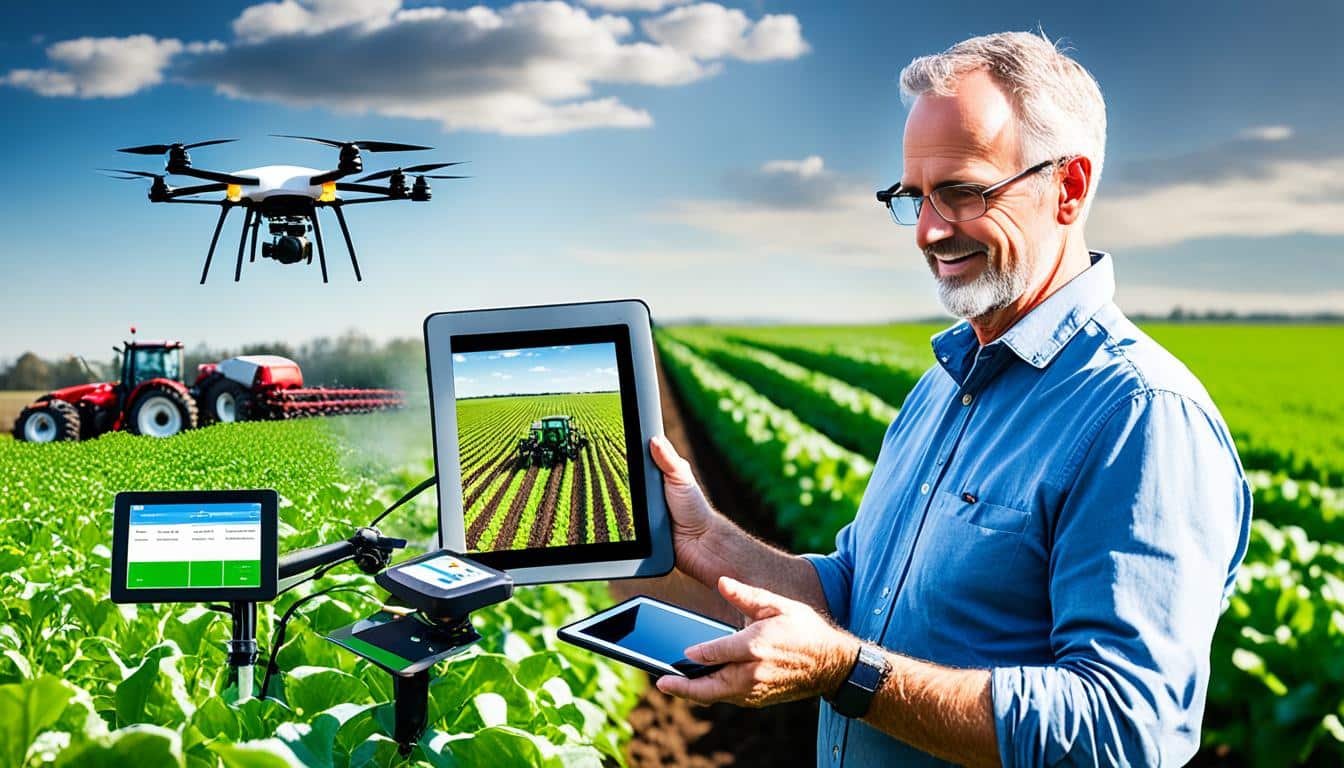
Did you know Charles Sturt University’s farm in New South Wales, Australia, covers 1,600 hectares? This shows why it’s so important to use smart farming and agri-tech to manage land well. Thanks to new digital farming methods, using technology in agriculture has changed a lot. These changes help farms be more efficient and create food in a better way.
Farms now use GPS and sensors to manage resources better. They also use apps to monitor all the farm’s processes. These tech upgrades not only boost how much food we make but also make sure farming is kind to the environment. At Charles Sturt University, they show how going digital can make farms work better and smarter, all while being kind to our planet.
Digital farm management is changing the face of farming. It’s moving from traditional ways to smart, data-focused procedures. This change is key for agriculture today. It helps farmers do their jobs better and smarter.
The University of Illinois is at the forefront of digital agriculture with new study options. It offers joint degrees in Computer Sciences + Crop Sciences and Animal Sciences. These degrees bring technology and farming together. The university also leads in research with projects like the Illinois Digital Farm Infrastructure.
Farm management software is bringing farming tasks all together. These smart programs are reducing mistakes and work for farmers. The University of Illinois is starting a new program. It will teach about using computer science in farming. This shows how important tech is in agriculture.
The Center for Digital Agriculture works with many farm and food groups worldwide. It focuses on four main areas: Automation, Data, Animals and Crops, and People in Agriculture. This work shows the crucial part digital tools play in farming today.
Precision farming changes how we farm by using advanced tech to manage resources and improve crops. It uses data analytics, GPS, and sensors to watch over fields. This makes farming more efficient and kinder to the planet.

Precision farming cuts back on waste, thanks to tools like GIS and VRT. These let farmers use water, fertiliser, and pesticides exactly where they’re needed. This lessens costs and helps the environment.
This method helps to grow more crops and use resources better, which means farmers earn more. With data at their fingertips, farmers can quickly find solutions to problems. This makes their farms run better and produce more.
Using less pesticides and smarter fertiliser use keeps the soil healthy and the farming eco-friendly. This way, we can farm now without hurting our ability to farm in the future.
Using the latest tech trends is changing the future of agriculture. For example, drones are now used to scan fields from above. They take detailed pictures to help find issues and check on plant health.
Mobile apps are now key in precision farming. Farmers get instant updates on their fields and the weather. This helps them manage their farms better. They can keep track of what they do and boost their farm’s performance.
Farm software helps in real-time monitoring of the work on fields. It puts many farm jobs in one place. This makes it easier to share work between people and get the most from the land. Combined with GPS and satellite data, precision farming is getting even better at tracking yields and planning fields.
“According to McKinsey & Company, precision agriculture is described as ‘a technology-enabled approach to farming management that observes, measures, and analyses the needs of individual fields and crops.'” — McKinsey & Company
Smart farming systems are transforming agriculture today. They mix technology into machines and tools, making farms into centres of data-driven agriculture. This new approach boosts farming efficiency, cuts down waste, and lifts productivity.
In Japan, farmers’ average age hit 68 by 2023, showing a need for fresh solutions. The number of active farms also dropped sharply. From 2.3 million in 2000, it went down to 1.02 million by 2020. Smart farming technologies play a key role in boosting how well agriculture works and its eco-friendliness.
| Statistic | Data |
|---|---|
| Average age of farmers in Japan (2023) | 68 years old |
| Farms engaged in sales in Japan (2000) | 2.3 million |
| Farms engaged in sales in Japan (2020) | 1.02 million |
| Farmland owned by professional farmers in Japan (2021) | 58.9% |
| Global farming population (2000) | 1 billion |
| Global farming population (2019) | 900 million |
| Greenhouse gases from agriculture, forestry, and land use | 24% of total global emissions |
Key smart farming tools include drones, sensors, robotics, and IoT gear. These devices collect vital data on soil, weather, and plants. This data helps farmers make better decisions, increasing efficiency. For example, Kubota has made the first self-driving combine harvester, with full remote control planned by 2026.
Digital agriculture’s fast growth has led to investing in various new ideas. These include sensors, IoT, automation, blockchain, and artificial intelligence, marking a new farming stage. They help big and small farmers alike, making farming efficient and able to feed everyone while protecting the earth.
Kubota is also committed to cutting greenhouse gases from farming. This is crucial since farming and land use emit about a quarter of the world’s greenhouse gases. Kubota’s Farm Management Information System (FMIS) signals its push for green and effective farming.
New Holland brought out FieldOps™ at Agrishow 2024. This is a big step in farming tech, giving farmers all over the world real-time data handling. With so many farm machines now connected to the internet, New Holland wants to lead in this area. They’re aiming to connect even the remote parts with weak internet signals.
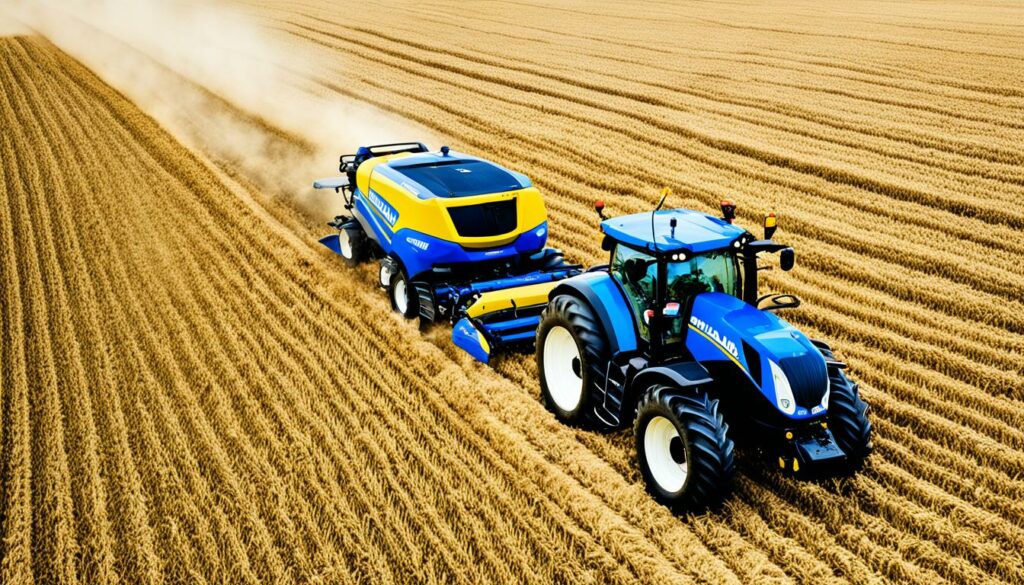
The FieldOps app is quickly getting ready for its big release. New Holland is showing its strong focus on tech in agriculture with this. It’s all about making a farmer’s job easier and more efficient, which in turn makes farms more profitable.
FieldOps is packed with tools that work well alongside different brands of farm machinery. This means farmers get to see everything about their machines in one place. They can keep an eye on their machines live, see what’s on the displays from far away, and check out detailed farming data. The collaboration with Intelsat makes sure even far-off places can use this tech. It really helps farmers get their data organised and work more smoothly.
Those who’ve tried New Holland FieldOps early liked it a lot. They say it’s easy to use and comes with strong features. It’s great at connecting different machines together. The app lets you watch your machines work and health from a distance. This is really helpful for managing lots of machines from one place.
And the info about the soil and crops, it’s been a hit. This detailed data helps farmers grow more and use less. Early users say FieldOps is a big win for making farming smarter and simpler. This shows New Holland’s dedication to making the best tech for all kinds of farm machines.
| Feature | Description |
|---|---|
| Real-Time Machine Monitoring | Allows for constant oversight of all machinery activities. |
| Remote In-Cab Display Viewing | Enables farmers to view machine displays from a distance. |
| Agronomic Data Layers Visualisation | Provides comprehensive insights into crop health and yield optimisation. |
| Location Tracking | Tracks the real-time location of all field machinery. |
| Machine Health Monitoring | Continuously checks the operational status and health of machinery. |
Modern farming is changing fast, thanks to automation and high-tech like robots and AI. These changes help deal with big problems in farming. They tackle issues like not having enough workers and the push for farming to be more efficient and green.
Farm robots are key in making farming better. They do jobs like picking, planting, and getting rid of weeds, making things more productive while needing fewer people. So, for example, robots can harvest day and night, picking crops perfectly on time, something that used to need lots of people.
These benefits are obvious, especially when you know about half of the people growing food in the U.S. are losing money. By using robot tech in farming, these businesses can work better, save money, and ease the financial squeeze.
AI tech in farming is a big move that’s changing the game. It helps predict how much food you’ll get, warn about bugs that might destroy your crops, and predict the weather. This lets farmers make smart choices to grow more food better. AI is also great at telling if the soil is good and at handling crops with up-to-date info.
AI doesn’t stop there. It also helps manage water use really well, looking out for leaks and cutting down on wasting water. This smart water use is super important, especially when thinking about how old some farming tools are. For example, the tractor hasn’t changed much in a hundred years.
Technologies like smart sensors and using the cloud to share data work well with AI. They give constant updates on how the plants are doing, the soil wetness, and the weather. Combining all these technologies can boost how much food is grown, cut costs, and keep farming places greener.
Agri-tech innovations are changing farming by making it more efficient and eco-friendly. They cover a wide range of tools and methods. For example, the use of Gen AI through Digital Crop Advisors gives farmers valuable advice.
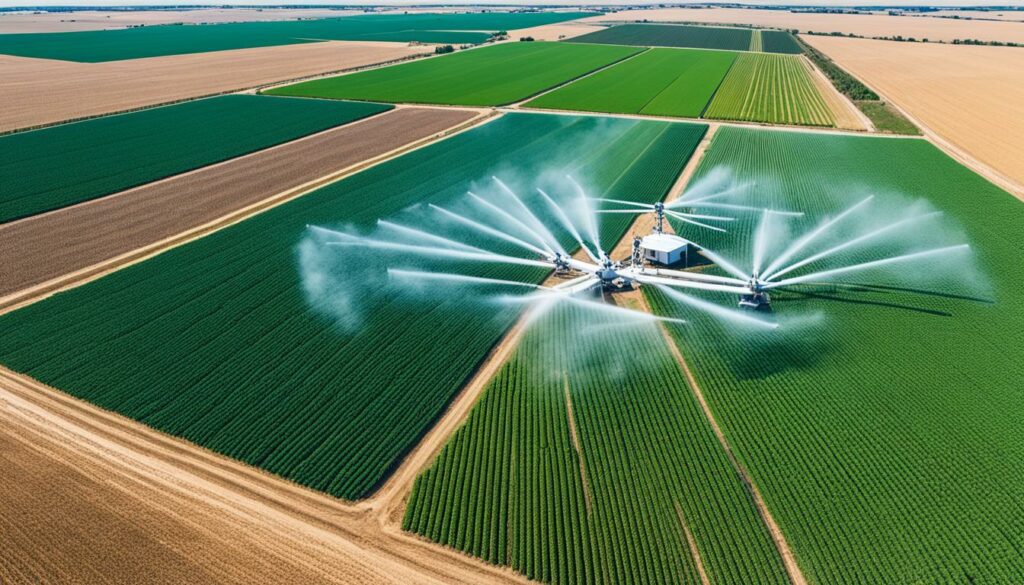
New crop protection products have been costly to develop, with field trials making up a big part of that. Cloud tools now make getting real-time data from trials easier and cheaper. This means more trials can be done. Also, synthetic data is helping speed up the process of making new agricultural products available.
Farming is set to collect a lot more data in the future, according to the IDC. This surge in data shows the big push for tech in agriculture. New digital tools help farmers with tailored solutions, making their work more efficient and profitable.
Precision farming is making the best use of resources with the help of GPS, IoT, and drones. Drones can give detailed info about fields, helping farmers use resources smarter. Computer vision tech supports things like spot disease in crops and enhancing weed control effectively.
AI and machine learning play a big role in farming, too. They help forecast the weather, predict crop yields, and identify pest problems. Companies are adding blockchain to these tools to guarantee farming is sustainable and fair.
Agri-tech isn’t just about the field. It’s also helping ensure food quality through automation and computer vision. For instance, Xihelm uses AI in robotic harvesting. This is an example of high-tech in farming.
Vertical farming is a key solution to feed more people as our land gets smaller. It grows crops in layers with the help of water-based systems. This method uses space very efficiently and increases yield, especially in cities.
In this digital age, big data from farming is changing things. It makes traditional farming smarter through better decisions. Various tools are used to collect, analyse, and apply big data. This helps improve farming’s productivity and care for the environment.
By 2050, we’ll need to feed 9.6 billion people. That’s 40% more than today. But we can’t use much more land. This makes smart farming key.
Data tech allows farmers to use resources better. It improves how they grow crops and look after the land.
From sensors to satellites, data is gathered in real-time. This info helps farmers decide where to put their resources. They can plan better, water more efficiently, and control pests.
Big data is already making a big difference in farming. Take Landsat satellite data, for instance. It’s been helping since 1972. Now, we can make detailed soil maps and monitor agriculture worldwide. GPS has also made farming more exact over the years.
Back in 2015, over US$4.6 billion was invested in farming tech. This shows how serious the sector is about using data. It’s paying off with lower waste, better farming, and more food.
| Key Statistics | Implication |
|---|---|
| 40% increase in global population by 2050 | Highlighting the necessity for efficient food production |
| 70% more food production required | Demands optimisation of farming resources |
| US$4.6 billion in agri-tech investment (2015) | Significant growth in agricultural technology adoption |
| 1.3 billion tons of food wasted annually | Necessitates better resource management and data analytics |
In summary, big data and its use in farming are changing everything. They’re helping farmers make smarter choices. This isn’t just boosting how much we farm. It’s making farming more sustainable and efficient for the future.
The importance of sustainable agriculture is huge today. The United Nations says the world’s population will be 2 billion more by 2050. To feed them, we need to produce 70% more food. So, sustainable farming is key for future food and environmental health.
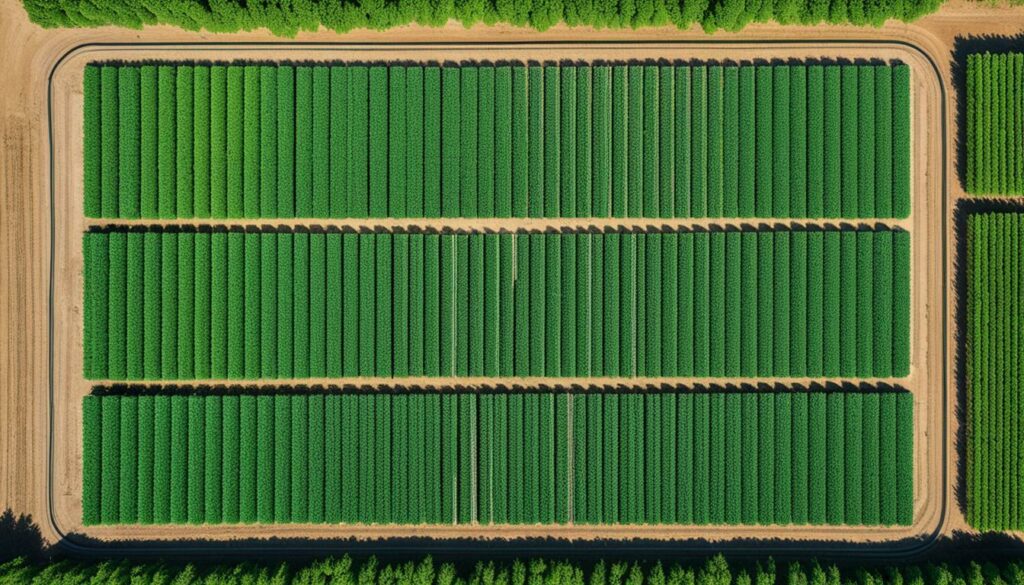
Agriculture is essential worldwide, making up 3% of the global GDP. In Least Developed Countries (LDCs), it can be as much as 60%. The Food and Agriculture Organization (FAO) highlights the importance of Good Agricultural Practices (GAP) for safe and sustainable food. Smart farming, using technologies like AI and IoT, allows for efficient crop management. This approach is essential for saving resources, especially in places with little rainfall.
Several techniques in sustainable farming are making big impacts. Precision farming, with data analysis and technology, reduces waste and increases crop yields. It improves soil health by applying the right nutrients where needed. This keeps food production sustainable in the long run.
Reducing the use of chemicals and having minimal tillage are also important. These practices are good for the environment and keep farms productive. Studies continue to show that smart agriculture improves efficiency and yield.
| Technique | Benefits |
|---|---|
| Precision Farming | Reduced wastage, increased yields, improved environmental sustainability |
| Reduction of Chemical Inputs | Decreased pollution, healthier crops, safer food |
| Conservation Tillage | Improved soil health, reduced erosion, enhanced organic matter |
| IoT-based Irrigation | Efficient water use, better crop management, sustainability in arid regions |
In today’s changing world, agriculture is welcoming new technologies. These innovative methods help farmers grow more sustainably and efficiently.
Vertical farming stands out as a key achievement. It uses 70% less water than traditional farming. Not only does it save space, but it also meets the demand for resource efficiency. The world’s greenhouses, worth almost US $350 billion each year, show the promise of such methods in feeding more people.
Another area seeing big growth is precision agriculture, set to hit $43.4 billion by 2025. This field uses AI and smart sensors to check on plant health, soil, and weather. These insights help farmers boost their crop yields and use resources better.
Blockchain technology is also making waves in farming. It tackles issues like false food claims, product recalls, and unclear supply chains. By making the whole process more clear and accountable, it helps ensure food safety.
Artificial intelligence isn’t left behind. It gives farmers powerful tools to manage their crops better. AI can monitor soil, warn about pests, and even help with watering. This tech is proving to be a game-changer in agriculture.
All these new technologies and methods are changing the face of farming. They promise a future where agriculture is more effective, sustainable, and profitable around the globe.
Agdata provides state-of-the-art solutions for managing big farms. It uses high-tech tools like satellite images and sensors. These tools improve farming by offering detailed maps and quick advice for those working on the land.
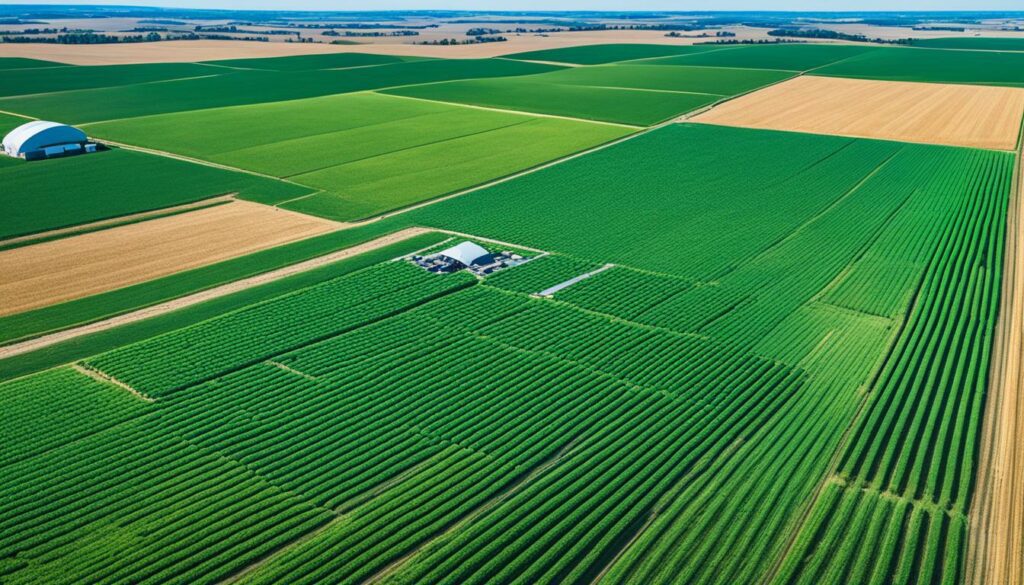
Agdata relies on satellite images and sensor data for large farms. The ESA’s Sentinel 2A satellite and others give farmers key information. Sensors in machinery and on animals help track crop health and the environment.
Agdata’s system boosts large-scale farm management in several ways. It helps with:
Agdata makes sure data is easy to share among all involved in farming. This includes farmers, experts, and those who offer farming services. It supports working together smartly and with good information.
| Feature | Benefit |
|---|---|
| 99.9% Up-time | Reliable and consistent data availability |
| Continuous Updates | Up-to-date technology and system improvements |
| High-Resolution Satellite Images | Detailed farm monitoring and precise decision-making |
| Integrated Sensors | Real-time insights and improved operational efficiency |
xFarm Technologies is changing how farming works with its advanced platform. It focuses on being green and effective. The system helps in many ways from using space images to IoT sensors. This ensures farmers have everything they need for better farming.
The xFarm solution has many useful features for managing farms better. It includes:
The platform starts at €195/year, making it affordable for all farms. It’s available in 7 languages, so anyone can use it.
xFarm uses the latest tech to increase how much food farms can grow. Its online system works on any gadget. It also works with many other farm tools and software.
The system makes farming smarter by offering tips from big data. It helps farmers make better choices. This cuts down waste and raises crop amounts.
Here’s a look at what xFarm does, compared to old ways:
| Capabilities | Traditional Methods | xFarm Solution |
|---|---|---|
| Resource Management | Manual and time-consuming | Automated and precise |
| Yield Prediction | Rough estimates | Data-driven models |
| Irrigation Control | Manual adjustments | Automated systems |
| Supply Chain Transparency | Limited traceability | Blockchain integration |
In short, xFarm gives farmers tools to work smarter and greener. It helps prepare farming for tomorrow’s challenges. This will lead to a greener, more efficient farming.
Digital pest control is key in today’s farming. Agrointeli leads in this area. It offers a high-tech system using satellite images to oversee crops closely. This helps manage pests early, stopping outbreaks and keeping crops healthy for longer.

Agrointeli combines digital pest control with watching crops’ health. This means precise and effective pest management. The system gives up-to-the-minute data so farmers can act fast and smart. This boosts using eco-friendly farming methods. Also, it uses weather and local data to match treatments with the needs of each field.
Agrointeli’s work has made big waves in farming. It was one of the top five solutions at the Global Startup Heat Map. This is among 784 similar companies. Its system offers amazing insights and control. This makes farming more sustainable and efficient. It shows how closely watching pests and crops is key for farming’s future.
Precision farming solutions are vital in today’s changing agriculture world. PreAgri stands out with its cutting-edge precision farming platform. This system uses automated farm sampling and detailed data analysis. It’s changing the way farming is done.
PreAgri’s system automates how soil samples are taken and tested. It connects with the latest tech for real-time tracking. This means farmers get accurate reports on soil health and nutrients without doing it by hand. This tech reduces manual work and ensures data is precise.
By using biomass data, farmers understand their crops better. They see growth stages and can plan resources better. This leads to using agricultural inputs wisely and getting better yields. It also helps in keeping resources in check.
PreAgri tackles key challenges in farming, from production to harvest. This boosts productivity and saves costs. With global warming and shifting climates, farmers need tools like PreAgri for sustainable success.
Digital vertical farming is advancing our journey to a greener, more sustainable future. The Grownetics system is at the forefront of this change. It uses open software, 3D maps, and smart sensors to help farmers yield more crops with less waste.
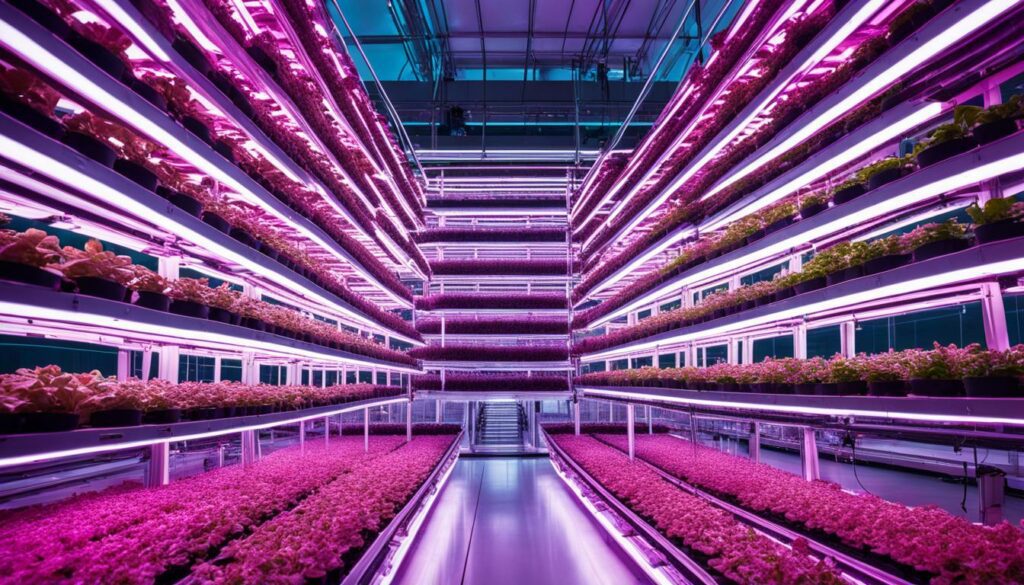
The Global Startup Heat Map singled out Grownetics as a top player in digital agriculture. It joins key systems from the Czech Republic and Italy in leading digital change. Yet, it’s the Grownetics system’s unique wireless range, long sensor life, and efficient staff use that standout.
The Grownetics system boosts yields by over 20% while cutting up to 60% of costs. It brings together sensor tech, greenhouse controls, and other tools seamlessly. This makes it easier for farms to operate and innovate, whatever their size or specialty.
| Feature | Grownetics System | Industry Standard |
|---|---|---|
| Yield Increase | 30-60% | 10-20% |
| Precision | 10-20x | 2-4x |
| Sensor Range | Up to 2 miles | 0.5-1 mile |
| Battery Life | 2-5 years | 1-2 years |
Grownetics is not just a promise but a reality in North American farming. As urban farming integrates more tech, Grownetics plays a crucial role. It follows the path of smart, sustainable farming, aligning with global goals.
Drones have revolutionised agriculture, leading to significant growth and efficiency. By 2024, the market for agricultural drones is projected to grow from $1.2 billion to $4.8 billion. This increase is due to the many advantages these technological tools bring.
Among the key benefits of agricultural drones is their ability to analyse land from above. They can perform detailed aerial surveys, creating precise maps of fields. This mapping includes important elevation data for drainage and to spot wet or dry areas. With such detailed information, farmers can make better irrigation and crop management decisions. This approach is boosting productivity by as much as 5%. In South Korea, drones are already being used in 30% of agricultural spray operations. They’re particularly good at applying fine sprays and cutting down on chemical costs.
Looking ahead, the role of drone technology in farming is set to expand dramatically. Features like automated harvesting, detailed soil analysis, and precise yield forecasts will become more common. The future will also see drones powered by AI, making them more useful on small, varied farms. These advances are of special interest to developing nations. They see drones as a key way to boost farm productivity in a sustainable manner.
| Aspect | Traditional Methods | Drone Technology |
|---|---|---|
| Resource Use | Higher due to less precision | Lower, optimised input application |
| Soil Compaction | Higher, due to wheeled vehicles | Lower, as drones do not compact soil |
| Environmental Impact | Higher chemical runoff and water use | Diminished through targeted applications |
To close, while there are challenges like regulations and the cost of drone technology, the payoff in farming is well worth it. For every acre, the potential benefit ranges from $2 to $12, depending on the crop. The interest and investment in drones is growing. Governments are backing the technology, and its economic advantages are clear. This points to a bright future for drones in agriculture.
Farmers in the 21st century face big challenges due to globalisation and changing prices. But, technology is helping them a lot. Thanks to new tech, farming has become more efficient. It uses tools that help with money, people, and managing risks.
A big help is the rise of farm software. Services like ClimateAi, FarmLogs, and Granular make tasks easier. They help with tracking stock, handling money flows, and managing staff costs. Plus, they do more like keeping an eye on crops and predicting the weather. This means more successful farms in the future.
The move towards smart farming is really taking off. It could grow the market past 15 million USD by 2024. Smart farming means using resources better for more crops. This move is also boosting the start-up world in farming. It shows people believe in new farming tech.
Farming’s future is deeply connected to technology. Using the latest digital tools will make farming better. It will help with food, social, and environmental challenges. We’re creating a future where farming is both fruitful and eco-friendly.
New farming techniques like smart farming and precision agriculture have become popular. They use technology to make farming more efficient and less wasteful.
Digital farm management uses tech tools to make traditional farming better. It includes software and gadgets that help farmers use data wisely.
This technology lowers waste, boosts crop yields, and uses resources better. It also helps the environment. By using more data and careful farming, operations become more effective.
Today, farmers use smart tech more, like changing the amount of seed in different areas. They also watch their fields in real-time and use drones for close checks. These methods make farming more efficient and productive.
Smart farming uses technology in farm machinery. This makes farming more careful and less wasteful. It’s better for the environment, too.
New Holland’s FieldOps makes managing many machines easier. It lets farmers check their machines from afar, see how they work, and look at farming data easily. This makes farming tasks simpler after each season.
Users say New Holland’s FieldOps is easy and useful. It connects different tasks on a farm well, making work simpler and more efficient.
Robotics and AI do jobs like picking and sowing. AI also forecasts crop health and helps farming be more exact and efficient. They make tough tasks easier and do farming better.
Agdata offers big-farm-friendly tech, including tools for watching machines and workers, and tracking animals. This helps with better decision making and farm operations.
xFarm’s system maps and collects data. It also helps make farming more exact in things like watering and fertilising. This means better crops and farming efficiency.
Grownetics focuses on digital farming in cities, giving farmers smart data and tools. They use technology to watch crops closely, leading to bigger yields and better quality in cities.
Drones offer a lot, like checking fields closely, making smart choices about crops, picking automatically, and predicting yields well. They are making farming smarter and more data-driven.